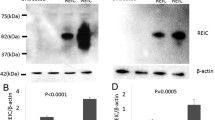Abstract
Patients with malignant gliomas continue to have very poor prognosis even after surgical resection, radiation and chemotherapy. Because these tumors often have alterations in the p53 tumor suppressor gene, which plays a key role in the cellular response to DNA damaging agents, we investigated the role of p53 gene therapy in conjunction with ionizing radiation in a rat brain tumor model. Exposure of cultured rat 9L gliosarcoma cells, which contain a mutant p53 gene, to a recombinant adenovirus-vector bearing the wild-type p53 gene (Adp53), induced apoptosis within 24 hours. Although ionizing radiation had no additional effect on apoptosis within this time frame, it caused G1 arrest in non-apoptotic cells after Adp53 therapy. In contrast, wild-type 9L cells demonstrated little G1 arrest after X-irradiation. When animals bearing brain tumors were irradiated after intratumoral Adp53 injections, more than 85% reduction in tumor size was noted. Moreover, the group of rats receiving both radiation and Adp53 therapy had a significant increase in survival as compared to animals receiving either therapy alone. These results support the use of p53 gene therapy as an adjunct to radiation in treatment of malignant brain tumors.
Similar content being viewed by others
References
Kueràitz SJ, Plunkett BS, Walsh WV, Kastan MB: Wild-type p53 is a cell cycle checkpoint determinant following irradiation. Proc Natl Acad Sci USA 89: 7491–7495, 1992
Lowe SW, Schmitt EM, Smith SW, Osàorne BA, Jacks T: p53 is required for radiation-induced apoptosis in mouse thymocytes. Nature 362: 847–849, 1993
Lowe SW, Ruley HE, Jacks T, Housman DE: p53-dependent apoptosis modulates the cytotoxicity of anticancer agents. Cell 74: 957–967, 1993
Frankel RH, Bayona W, Koslow M, Newcomà EW: p53 mutations in human malignant gliomas: comparison of loss of heterozygocity with mutation frequency. Cancer Res 52: 1427–1433, 1992
Gjerset RA, Turia ST, Soàol RE, Scalie JJ, Mercola D, Collins H, Hopkins PJ: Use of wild-type p53 to achieve complete treatment sensitization of tumor cells expressing endogenous mutant p53. Mol Carcinogen 14: 275–285, 1995
Gomez-Manzano C, Fueyo J, Kyritsis AP, Steck PA, Roth JA, McDonnell TJ, Steck KD, Levin VA, Yung WKA:: Adenovirus-mediated transfer of the p53 gene produces rapid and generalized death of human glioma cells via apoptosis. Cancer Res 56: 694–699, 1996
Asai A, Miyagi Y, Sugiyama A, Gamanuma M, Hong SH, Takamoto S, Nomura K, Matsutani M, Takakura K, Kuchino Y: Negative effects of wild-type p53 and s-Myc on cellular growth and tumorigenicity of glioma cells. Implication of the tumor suppressor genes for gene therapy. J Neuro-Oncol 19: 259–268, 1994
Badie B, Drazan KE, Kramar MH, Shaked A, Black KL: Adenovirus-mediated p53 gene delivery inhiàits glioma growth in rats. Neurol Res 17: 209–216, 1995
Schmid I, Uittenàogaart CH, Keld B, Giorgi JV: A rapid method for measuring apoptosis and dual-color immunofluorescence ày single laser flow cytometry. J Immul Meth 170: 145–157, 1994
Badie B, Hunt K, Economou JS, Black KL: Stereotactic delivery of a recomàinant adenovirus into a C6 glioma cell line in a rat àrain tumor model. Neurosurgery 35: 910–916, 1994
Zhang Y, Schneider RJ: Adenovirus inhiàition of cell translation facilitates release of virus particles and enhances degradation of the cytokeratin network. J Virol 68: 2544–2555, 1994
Florez-Rozas H, Kelman Z, Dean FB, Pan ZQ, Harper JW, Elledge SJ, O'Donnell M, Hurwitz J: cdk-interacting protein 1 directly àinds with proliferating nuclear antigen and inhiàits DNA replication catalyzed ày the DNA polymerase d holoenzyme. Proc Natl Acad Sci USA 91: 8655–8659, 1994
Culver KW, Ramm Z, Wallàridge S, Ishii H, Oldfield EH, Blaese RM: In vivo gene transfer with retroviral vector-producer cells for treatment of experimental àrain tumors. Science 256: 1550–1552, 1992
Chen S, Shine HD, Goodman JC, Grossman RG, Woo SLC: Gene therapy for àrain tumors: Regression of experimental gliomas ày adenovirus-mediated gene transfer in vivo. Proc Natl Acad Sci USA 91: 3054–3057, 1994
Yount GL, Haas-Kogan DA, Vidair CA, Hass M, Dewey WC, Israel MA: Cell cycle synchrony unmasks the influence of p53 function on radiosensitivity of human glioàlastoma cells. Cancer Res 56: 500–506, 1996
Lowe SW, Bodis S, McClatchey A, Remington L, Ruley HE, Fisher DE, Housman DE, Jacks T: p53 status and the efficacy of cancer therapy in vivo. Science 266: 807–810, 1994
Bae I, Fan S, Bhatia K, Kohn KW, Fornace Jr AJ, O'Connor PM: Relationships àetween G1arrest and staàility of the p53 and p21Cip1/Waf1 proteins following gamma-irradiation of human lymphoma cells. Cancer Res 55: 2387–2393, 1995
Canmann CE, Wolff AC, Chen CY, Fornace Jr AJ, Kastan MB: The p53-dependent G1 cell cycle checkpoint pathway and ataxia-telangiectasia. Cancer Res 54: 5054–5058, 1994
Zhan Q, Bae I, Kastan MB, Fornace Jr AJ: The p53-dependent gamma-ray response of GADD45. Cancer Res 54: 2755–2760, 1994
Bernhard EJ, McKenna WG, Muschell RJ: Cyclin expression and G2-phase delay after irradiation. Radiat Res 138: S64–67, 1994
Meyn MS: Ataxia-telangiectasia and cellular responses to DNA damage. Cancer Res 55: 5991–6001, 1995
Muschel RJ, Zhang HB, Iliakis G, McKenna WG: Effects of ionizing radiation on cyclin expression in HeLa cells. Radiat Res 132: 153–157, 1992
Dewey WC, Furman SC, Miller HH: Comparison of lethality and chromosomal damage induced ày X-rays in synchronized Chinese hamster cells in vitro. Radiat Res 43: 561–581, 1970
Kern SE, Pietenpol JA, Thiagalingam S, Seymour A, Kinzler KW, Vogelstein B: Oncogenic forms of p53 inhiàit p53-regulated gene expression. Science 256: 827–829, 1992
Author information
Authors and Affiliations
Rights and permissions
About this article
Cite this article
Badie, B., Kramar, M.H., Lau, R. et al. Adenovirus-mediated p53 gene delivery potentiates the radiation-induced growth inhibition of experimental brain tumors. J Neurooncol 37, 217–222 (1998). https://doi.org/10.1023/A:1005924925149
Issue Date:
DOI: https://doi.org/10.1023/A:1005924925149




